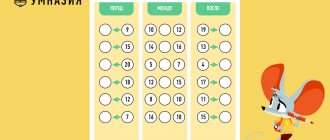Idea of size
The plan should indicate how to compare and measure quantities. Take the nesting dolls and explain to the kids where the smallest and largest are. It is not advisable to compare 3 or more objects at once; children will quickly get confused. For starters, two toys are enough. The size can be compared not only by height, but also by length. These can be bright multi-colored ribbons (long – green, short – pink). Also by thickness (the doll is thin, the bunny is fat).
In order for children to be interested in learning about size, you can tell them a story: “The prince and princess are going to a carnival, they need beautiful belts, here are ribbons, short and long, who should we tie them to?” Two kids come out and tie the knot. After a while, the teacher says: “Oh, the prince and princess want to exchange belts, who will help them?” Two other kids come out. As a result, the ribbons can be placed one on top of the other and show how to figure out where the short and long are. In this way, children develop fine motor skills of their fingers and the idea of size.
Advice for parents and educators
There is no need to scold your child if something doesn’t work out for him. Or he forgot the name of the shape or color. You may disappoint him in his studies. If the baby cannot cope with something, help him tenderly, with a smile on his face. You will see how eagerly he wants to prove to others that he can do anything. The most important thing in pedagogy is to be patient. What is elementary for adults seems very difficult for a child. Put yourself in the baby's shoes: how will you feel if you are yelled at? Of course, anger. The baby feels the same, but he can’t express much. Be a kind and patient teacher, only then will you be able to achieve the desired results.
What should children be able to do at the end of the school year?
When all the lessons that were planned have been completed, then you can consolidate what you have learned with the kids. As a result, children should be able to:
1. Find out how many items they have (many, few, none).
2. Must understand the difference between big and small.
3. What kind of strip, ribbon, path (wide-narrow, long-short).
4. Where the toy is thick, where it is thin.
5. What is morning or night.
6. Must be able to determine: what is below, above, in front, behind, on the left, on the right.
7. Where is their head, arms, legs, etc.
8. Must distinguish between shapes and colors.
Features of quantitative representations
It has been proven that children learn more easily while playing. If you only conduct classes with them, it will be boring, uninteresting, and the kids will quickly stop liking learning new things. Children should be given instructions to form elementary mathematical concepts only in the form of games. In the second younger group, they learn to distinguish when there are many objects and when there are none. Try giving him two toy bunnies and then ask him how many he has. The kid will say: “Here is one and here is one.” If you give a 3.4 year old child 5-6 toys, he will say: “That’s a lot.”
You can hide them for 3 minutes and ask: “How many toys do you have?” The child will answer: “There is not one.” These are general answers. They may differ depending on the individuality of the baby, but the meaning will be the same. This applies to those children who cannot count.




